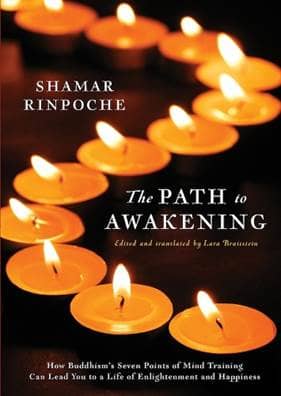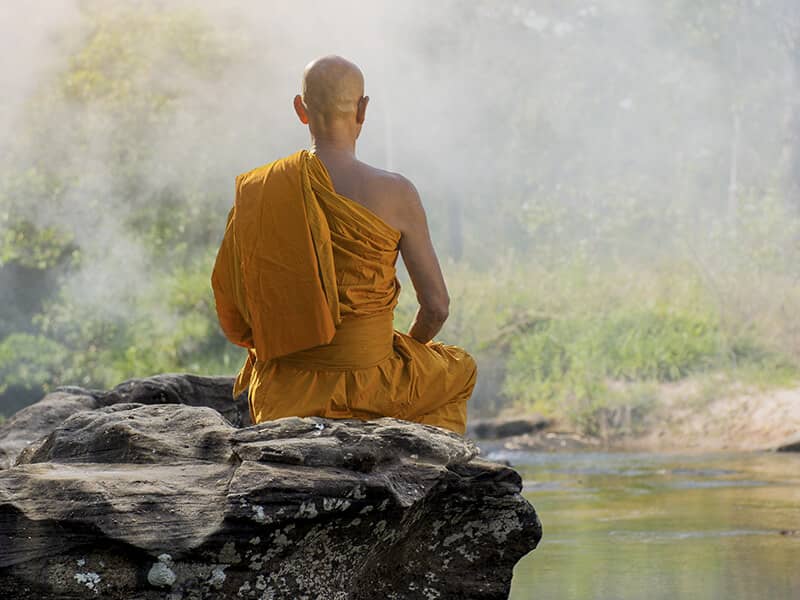
Excerpt from The Path to Awakening, from Chapter: Homage to the Great Compassionate One!
This is the key instruction, the essential nectar generated by Serlingpa.
Now we come to the main subject: the Seven Points of Mind Training. This is the key instruction of the Kadam school, the lineage of which comes from Atisha Dipamkara Srijnana (982-1054 C.E.). Though of course this key method comes from Buddha, for
a long time it was passed on as a secret oral tradition along a long lineage of great bodhisattvas.
It is called dütsi nyingpo, or essential nectar. The nectar is a liquid so pure that even one drop can purify a vast body of water. These instructions are like the very essence of that purifying, healing nectar.
This nectar is not only able to purify the mind, but when Atisha received these instructions he effectively purified the transmission of Buddhism as well. In the 11th century, Buddhism slowly started declining in India. This was exactly as Buddha had predicted. When he was teaching he repeatedly told his disciples that his teachings
would definitely disappear so it was critically important for them to practice diligently immediately. At every sojong (ceremony for purifying monastic precepts), he repeated this warning. So it happened that during Atisha’s time there began to be indications that this disappearance of the Buddha’s teachings from India was starting to happen. For example, during Atisha’s life, the combined lineages of the bodhisattva vow – the Maitreya-Asanga lineage and the Nagarjuna lineage – already disappeared from India.
Everybody was practicing one or the other, but not the two together. As a great bodhisattva, Atisha saw that in the future he could benefit beings in Tibet before Buddhism declined in India. He understood that by sowing the seeds of buddhadharma there, when it declined in India it would live on in Tibet. For that reason, he went all the way to Indonesia to meet Serlingpa, the only master who still held that combined lineage of the bodhisattva vow…
Like the diamond, the sun, the medicinal tree, it (the Seven Points of Mind Training, or Lojong) is the principal, ever precious discipline.
The Buddha gave many different teachings and instructions according to the abilities and propensities of his students. The methods vary in levels of difficulty and of accomplishment, but among the countless dharma practices, Lojong is the superlative discipline. It is as priceless as a perfect diamond. Its worth cannot be measured because it is the very key that opens the inner door to enlightenment.
Another simile distinguishes the brilliance of Lojong: these very precious teachings are said to shine as brightly as the sun itself. We have at our disposal all kinds of artificial light such as candlelight, gaslight, or electric light. But in the sun, all artificial lights are redundant. The sun completely dispels darkness and everything is shown clearly in its presence. Similarly, Lojong clears away the ignorance of our mind and reveals everything as it is.
A third simile highlights the special power of Lojong to accelerate our progress on the path: Mind Training is like the roots of a medicinal tree. The roots hold all the healing ingredients and these curative essences in turn permeate the entire tree: its trunk, branches and leaves, etc. Every single cell of the tree contains the medicines and we can harvest them through any of its parts. Similarly, Mind Training forms the best root for all dharma practice.
When Lojong has taken root in us, it imbues any practice we do with the same power to bring us swiftly to enlightenment. By these three similes, you should understand, know, and remember the superior qualities of Lojong which attest to its being the most valuable and meaningful practice in your life.
The Path to Awakening: How Buddhism's Seven Points of Mind Training Can Lead You to a Life of Enlightenment and Happiness (Delphinium Books/distributed by HarperCollins; February 11, 2014), by Shamar Rinpoche, provides a complete and simple guide to living a fulfilling life as a Buddhist, as well as a comprehensive manual of meditation techniques.

